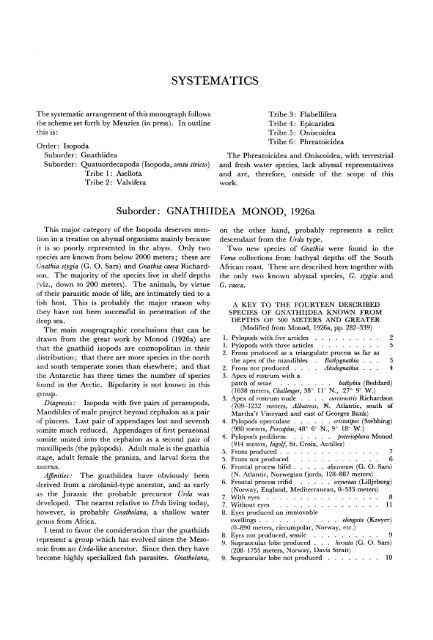The Isopods of Abyssal Depths in the Atlantic Ocean
The Isopods of Abyssal Depths in the Atlantic Ocean
The Isopods of Abyssal Depths in the Atlantic Ocean
You also want an ePaper? Increase the reach of your titles
YUMPU automatically turns print PDFs into web optimized ePapers that Google loves.
<strong>The</strong> systematic arrangement <strong>of</strong> this monograph follows<br />
<strong>the</strong> scheme set forth by Menzies (<strong>in</strong> press). In outl<strong>in</strong>e<br />
this is:<br />
Order: Isopoda<br />
Suborder: Gnathiidea<br />
Suborder: Quatuordecapoda (Isopoda, sensu stricto)<br />
Tribe 1: Asellota<br />
Tribe 2: Valvifera<br />
SYSTEMATIGS<br />
Tribe 3: Flabellifera<br />
Tribe 4: Epicaridea<br />
Tribe 5: Oniscoidea<br />
Tribe 6: Phreatoicidea<br />
<strong>The</strong> Phreatoicidea and Oniscoidea, with terrestrial<br />
and fresh water species, lack abyssal representatives<br />
and are, <strong>the</strong>refore, outside <strong>of</strong> <strong>the</strong> scope <strong>of</strong> this<br />
work.<br />
Suborder: GNATHIIDEA MONOD, 1926a<br />
This major category <strong>of</strong> <strong>the</strong> Isopoda deserves mention<br />
<strong>in</strong> a treatise on abyssal organisms ma<strong>in</strong>ly because<br />
it is so poorly represented <strong>in</strong> <strong>the</strong> abyss. Only two<br />
species are known from below 2000 meters; <strong>the</strong>se are<br />
Gnathia stygia (G. O. Sars) and Gnathia caeca Richardson.<br />
<strong>The</strong> majority <strong>of</strong> <strong>the</strong> species live <strong>in</strong> shelf depths<br />
(viz., down to 200 meters). <strong>The</strong> animals, by virtue<br />
<strong>of</strong> <strong>the</strong>ir parasitic mode <strong>of</strong> life, are <strong>in</strong>timately tied to a<br />
fish host. This is probably <strong>the</strong> major reason why<br />
<strong>the</strong>y have not been successful <strong>in</strong> penetration <strong>of</strong> <strong>the</strong><br />
deep sea.<br />
<strong>The</strong> ma<strong>in</strong> zoogeographic conclusions that can be<br />
drawn from <strong>the</strong> great work by Monod (1926a) are<br />
that <strong>the</strong> gnathiid isopods are cosmopolitan <strong>in</strong> <strong>the</strong>ir<br />
distribution; that <strong>the</strong>re are more species <strong>in</strong> <strong>the</strong> north<br />
and south temperate zones than elsewhere; and that<br />
<strong>the</strong> Antarctic has three times <strong>the</strong> number <strong>of</strong> species<br />
found <strong>in</strong> <strong>the</strong> Arctic. Bipolarity is not known <strong>in</strong> this<br />
group.<br />
Diagnosis: Isopoda with five pairs <strong>of</strong> peraeopods.<br />
Mandibles <strong>of</strong> male project beyond cephalon as a pair<br />
<strong>of</strong> p<strong>in</strong>cers. Last pair <strong>of</strong> appendages lost and seventh<br />
somite much reduced. Appendages <strong>of</strong> first peraeonal<br />
somite united <strong>in</strong>to <strong>the</strong> cephalon as a second pair <strong>of</strong><br />
maxillipeds (<strong>the</strong> pylopods). Adult male is <strong>the</strong> gnathia<br />
stage, adult female <strong>the</strong> praniza, and larval form <strong>the</strong><br />
anceus.<br />
Aff<strong>in</strong>ities: <strong>The</strong> gnathiidea have obviously been<br />
derived from a cirolanid-type ancestor, and as early<br />
as <strong>the</strong> Jurassic <strong>the</strong> probable precursor Urda was<br />
developed. <strong>The</strong> nearest relative to Urda liv<strong>in</strong>g today,<br />
however, is probably Gnatholana, a shallow water<br />
genus from Africa.<br />
I tend to favor <strong>the</strong> consideration that <strong>the</strong> gnathiids<br />
represent a group which has evolved s<strong>in</strong>ce <strong>the</strong> Mesozoic<br />
from an Urda-like ancestor. S<strong>in</strong>ce <strong>the</strong>n <strong>the</strong>y have<br />
become highly specialized fish parasites. Gnatholana,<br />
on <strong>the</strong> o<strong>the</strong>r hand, probably represents a relict<br />
descendant from <strong>the</strong> Urda type.<br />
Two new species <strong>of</strong> Gnathia were found <strong>in</strong> <strong>the</strong><br />
Vema collections from bathyal depths <strong>of</strong>f <strong>the</strong> South<br />
African coast. <strong>The</strong>se are described here toge<strong>the</strong>r with<br />
<strong>the</strong> only two known abyssal species, G. stygia and<br />
G. caeca.<br />
A KEY TO THE FOURTEEN DESCRIBED<br />
SPECIES OF GNATHIIDEA KNOWN FROM<br />
DEPTHS OF 500 METERS AND GREATER<br />
(Modified from Monod, 1926a, pp. 282-339)<br />
1. Pylopods with five articles 2<br />
1. Pylopods with three articles 5<br />
2. Frons produced as a triangulate process as far as<br />
<strong>the</strong> apex <strong>of</strong> <strong>the</strong> mandibles . Bathygnathia ... 3<br />
2. Frons not produced . . . . Akidognathia ... 4<br />
3. Apex <strong>of</strong> rostrum with a<br />
patch <strong>of</strong> setae bathybia (Beddard)<br />
(1638 meters, Challenger, 38° 11' N., 27° 9' W.)<br />
3. Apex <strong>of</strong> rostrum nude . . . . curvirostris Richardson<br />
(709-1232 meters, Albatross, N. <strong>Atlantic</strong>, south <strong>of</strong><br />
Martha's V<strong>in</strong>eyard and east <strong>of</strong> Georges Bank)<br />
4. Pylopods operculate cristatipes (Stebb<strong>in</strong>g)<br />
(980 meters, Porcup<strong>in</strong>e, 48° 6' N., 9° 18' W.)<br />
4. Pylopods pediform poteriophora Monod<br />
(914 meters, Ingolf, St. Croix, Antilles)<br />
5. Frons produced 7<br />
5. Frons not produced 6<br />
6. Frontal process bifid abyssorum (G. O. Sars)<br />
(N. <strong>Atlantic</strong>, Norwegian fjords, 128-887 meters)<br />
6. Frontal process trifid oxyuraea (Lilljeborg)<br />
(Norway, England, Mediterranean, 0-533 meters)<br />
7. With eyes 8<br />
7. Without eyes 11<br />
8. Eyes produced on immovable<br />
swell<strong>in</strong>gs elongata (Kreyer)<br />
(0-890 meters, circumpolar, Norway, etc.)<br />
8. Eyes not produced, sessile 9<br />
9. Supraocular lobe produced . . . hirsuta (G. O. Sars)<br />
(208-1755 meters, Norway, Davis Strait)<br />
9. Supraocular lobe not produced 10

















